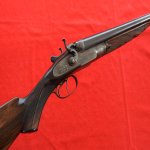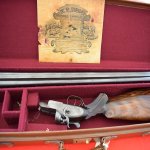Choke is one of those subjects that elicits strong responses. It is a clever solution to the problem of getting the most pellets into a given space, at a distance. To some, it is a panacea; to others a go-to excuse for missed shots. I consider choke a part of the mysterious, unknowable phenomena that occur milliseconds after the firing pin strikes the primer, hidden from view and happening too fast for human senses to make sense of. While barrel boring for best results was a frequent subject of conversation in the shooting newspapers back in the 1850s, it was still mysterious in that there were no standards, only gunmaker secrets. Some claimed opening the bore towards the muzzle gave tighter patterns, while others, correctly, believed the opposite to be preferred. There were fantastical claims of impossibly long shots on game, pooh-poohed as
Munchausen-esque by bewhiskered gentlemen over cigars and port. Wonderful reading.
While the invention of choke boring cannot be attributed to any one person or a specific century, the first patent can, and the honour goes to William Rochester Pape of Newcastle. But before bestowing too much credit, he included his method for choke boring as an afterthought to his patent for a new breech-loader action, which he obtained on 29 May 1866 and given No. 1501. The Pape action consisted of two bolts on a vertical spindle, operated by a small thumb lever to the right of and just in front of the trigger guard, under spring tension. The bottom bolt engages with a slot in the barrel lump, and the upper bolt engages with an extension above the barrels. Pape claimed that the action was self-tightening so that even after wear and tear, it would remain tight (becoming loose was one of the biggest fears of the revolutionary snap-actions at the time). The patent concentrated on the action, not on the choke boring, and it was not renewed in 1873, suggesting Pape did not consider choke boring to be of particular importance at the time, or worth protecting. As choke boring became a ‘thing’ when everyone started doing it, Pape stated to be its inventor, a claim shared with great acrimony with another Newcastle-born gunmaker, William Wellington Greener. In 1875, to settle the matter,
The Field newspaper set up a committee to decide the winner, and Pape won the £10 prize because of his patent. It did not stop Greener from subsequently claiming it was he who
perfected choke boring, to anyone who would listen.
It was with guns of the 1866 patent that William Rochester Pape won
The Field trial of 1866 in London. The trial ended up pitting Pape's choke-bored guns against mainly cylinder-bored guns. In the 12-bore class, Pape took first, second, fifth and seventh place out of a field of 32 guns (1st, 2nd and 5th were pin-fires, and 7th was a central-fire). Greener took third place with a ‘wedge fast’ pin-fire of his make. Only two guns were taking part in the 16-bore class, and Pape won with a pin-fire gun. Interestingly, pin-fire guns outperformed central-fire guns on that day, the last great hurrah of the pin-fire in Britain.
On 3 September 1867, Pape was granted patent No. 2488 for an improved design incorporating his thumb lever (sometimes called a ‘tap’ lever or ‘butterfly wing’ lever), and this latter patent is the one which is most frequently seen on Pape’s central-fire guns today, as he continued making them for some years. It can be distinguished from the first patent by the angle of the thumb lever, which lies at more of a right angle to the gun. Pape could not have made many guns of the first patent in the 14 months between the two designs.
Pape was known for having guns built for him in Birmingham, but he also produced them in his Newcastle workshop, where he employed nine workers and four apprentices. Whether Pape himself made guns is an open question. He aggressively and tirelessly promoted his business, such as participating in the trials and advertising widely in the sporting and general press. Of his 1866 patent gun, which he sold for £40, he announced it in
The Field, the
English Mechanic and Mirror of Science, and local papers, including the
Derby Mercury, the
Gateshead Observer, the
Kelso Chronicle, the
Leicester Mail, the
Lincolnshire Chronicle, the
Newcastle Courant, the
Newcastle Daily Chronicle, the
Newcastle Guardian and Tyne Mercury, the
Newcastle Journal, and the
Shields Daily News. This rush of advertising was more self-promotion than an expectation of business, as the number of people who could afford the most expensive gun would be few – but one can dream, I suppose. In his adverts, Pape could claim to have
“Won the only three great Sporting Gun Trials Open to the World,” and offering
“...unrivalled Steel-Barreled BREECH LOADERS made with our New Patent Pin or Central Fire Actions… all Bored upon Pape’s Principle, which stands unequalled by proof of Public Contests.” His range of guns started at £12, which was still a good bit of money then. Pape spent much of his time pursuing his other interests, namely dog breeding and falconry (in 1859, Pape organized the first dog show in Britain, held at the Newcastle-upon-Tyne Corn Exchange, offering one of his shotguns as a prize).
What does a £40, 1866-patent, William Rochester Pape pin-fire game gun look like? Here’s one. And it is only the 13th gun built to this patent – early indeed. It is a 12-bore made in 1866, number 1366. The top rib is signed
“W. R. Pape Newcastle on Tyne Winner of the London Gun Trials 1858, 1859, & 1866 Patent no. 13.” The bar locks are marked
“W. R. Pape,” and the action body is fluted in shape and engraved
“W. R. Pape’s Patent.” The gun is decorated in best foliate engraving with dogs in ovals (very appropriate, on a Pape gun). The hammers are well sculpted, and the forearm has ornate chequering borders, both characteristics of the maker. Main parts are initialled "WRP," so I presume the gun was made in the Newcastle workshop, and not made by another for Pape. The gun weighs a hefty 7 lb 14 oz, suggesting it might have been built as a live-pigeon gun. I do not possess the tools to measure choke boring correctly, but this gun likely has some degree of choke. Pape guns have always been well regarded for their quality, and by the late 1800s, Pape was known as “the Purdey of the North.”
Very special thanks go to
Ashcroft, whose eagle-eyes spotted this gem amongst gun-show chaff and helped me seal the deal with the seller, another splendid fellow. If you want to examine this important design closely, I suggest attending the 7th Annual Double Gun Classic, where the gun will sit amongst other remarkable pin-fires.


















































